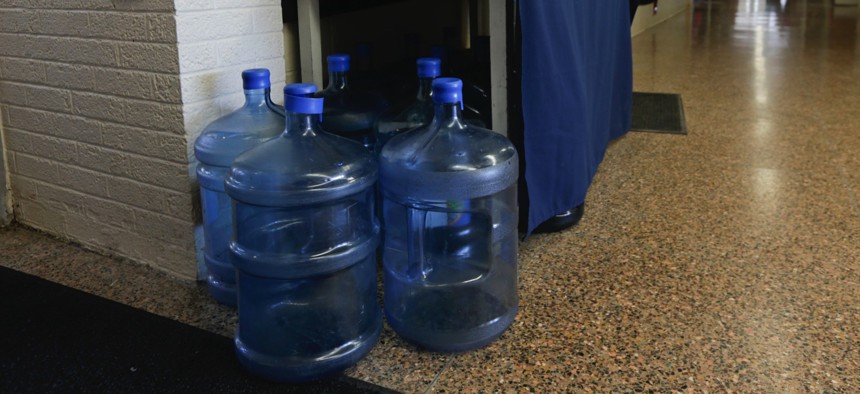New York Village Faces Its Own Toxic Water Crisis

Bottles of drinking water are seen in a hallway at St. Mary's Academy in Hoosick Falls, N.Y. Mike Groll / AP Photo
In Hoosick Falls, the discovery of high levels of a synthetic chemical, PFOA, has the town avoiding the tap. What comes next?
While the origins of their respective, ongoing municipal water crises are different, residents of Hoosick Falls, New York, and Flint, Michigan, share a few things in common right now.
They fear toxins coming from the tap and worry about health risks. They have to procure bottled water for drinking and cooking. Many take sponge baths to avoid washing in the tub or shower. And they’re also frustrated with the response from government agencies at the local, state and federal levels.
The problem in Hoosick Falls isn’t lead poisoning, as it is in Flint. Residents in the small village, located near the Vermont state line about 30 miles northeast of Albany, fear perfluorooctanoic acid , or PFOA.
The substance, which has been used for decades in non-stick cookware and other household products, has been studied for possible cancer-causing risks . PFOA is also in the process of being phased out by manufacturers , through a previous agreement with the U.S. Environmental Protection Agency.
The federal agency, which is currently studying a lifetime health advisory for the synthetic chemical, told Hoosick Falls residents in December to stop using the local tap water for drinking and cooking because of high PFOA levels.
The chemical had been first discovered in local water supplies in 2014, but it took many months for the official government response to take shape.
As the Times-Union reported Sunday, documents paint a picture of a complex multi-agency bureaucratic reaction , including “conflicting information and a lack of regulations” that delayed response at the New York State Department of Health and at the EPA. A regional administrator with the federal agency said she had not learned of the PFOA contamination until 10 months after the EPA was first made aware of the situation in December 2014.
Also, according to the Times-Union :
The records confirm that village leaders first contacted county and state health officials 18 months ago seeking guidance after they were told by a resident about the toxic chemical and its health effects. Still, the Village Board kept its initial inquiries about the pollution secret, including two meetings where village trustees discussed the matter behind closed doors in August and October 2014, according to village records.
In the meantime, residents are dealing with life without using municipal tap water, and as Politico New York reported recently: “Fear is taking hold in Hoosick Falls.”
Last month, New York Gov. Andrew Cuomo’s administration issued emergency regulations to declare PFOA to be a “hazardous substance” and classified a Saint-Gobain Performance Plastics Co. facility—the suspected source of PFOA in Hoosick Falls—as a state-level Superfund site.
Beyond the Hoosick Falls village water supply, PFOA has also been found in local groundwater and private wells.
“We are taking immediate and aggressive actions to protect the health of Hoosick Falls residents,” Cuomo said in a Jan. 27 statement. “These actions will ensure that the source and extent of PFOA contamination is identified, and all necessary steps are taken to swiftly address the chemical’s presence. My administration is investigating this situation fully, and we will do whatever is necessary to ensure safe, clean drinking water for local residents.”
The New York State Department of Environmental Conservation has asked the federal Environmental Protection Agency to add PFOA to the National Priorities List , which would make PFOA contamination sites eligible for federal Superfund cleanup resources.
The New York State Department of Health has dispatched personnel to Hoosick Falls to be available to answer questions about water testing and blood testing, which is supposed to start this month. The state has also set up a special PFOA hotline.
The Hoosick Falls village government—working with the state government and the site owner, Paris-based Saint-Gobain Performance Plastics—has been looking at ways to make local water supplies safe and settled on a granular activated carbon filtration system as a temporary measure to treat the water and bring the PFOA levels within safe levels.
“The Village Board has been working diligently with our engineers and the New York State Department of Health to identify a treatment system that could be obtained and installed quickly, at no cost to local residents," Village Mayor David Borge said in a Jan. 26 announcement. "We are hopeful that, once confirmatory testing of the new system demonstrates the safety of the water, EPA will inform the community that it is acceptable to use the water for household purposes.”
Federal, state and local officials were on hand to check out the new water filtration system this weekend.
The temporary filtration system is being paid for by Saint-Gobain, which has pledged its long-term support to work with officials to address the PFOA contamination and has been covering the costs of the bottled water shipments for local residents.
“We will still be here, and we’ll make it right for the people of Hoosick Falls,” Saint-Gobain Performance Plastics CEO Tom Kinisky told Albany’s WTEN-TV / News 10 in an interview.
In Hoosick Falls, a centralized water distribution point has been set up at a local supermarket. There’s also a volunteer group of “water angels” who deliver water to elderly, disabled and homebound residents.
While village officials think that having an upgraded filtration system up and running in a few weeks will be an important step forward, Borges, in a letter sent to EPA and state officials on Friday, said that a coordinated public education campaign is needed because of ongoing doubts in the community about the long-term safety of the water.
“...[N]umerous residents are now voicing skepticism about the effectiveness of the [granular activated carbon] system in reducing PFOA levels in drinking water,” Borges wrote.
“Our community needs answers to all their questions,” the mayor continued.
And there are still many questions to answer in Hoosick Falls—as there are in Flint.
Michael Grass is Executive Editor of Government Executive's Route Fifty.
NEXT STORY: Vacant Walmart Sites Create Giant Big-Box Stumbling Blocks for Local Governments






